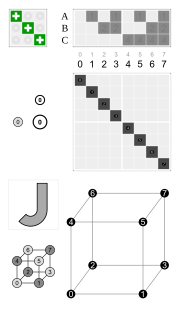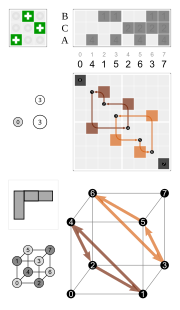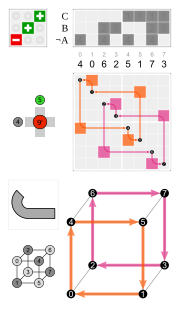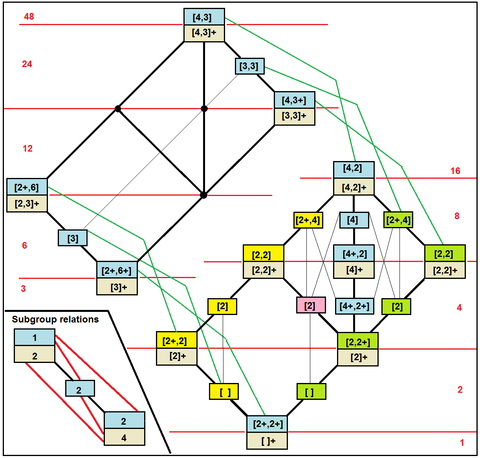Loading AI tools
3D symmetry group From Wikipedia, the free encyclopedia
A regular octahedron has 24 rotational (or orientation-preserving) symmetries, and 48 symmetries altogether. These include transformations that combine a reflection and a rotation. A cube has the same set of symmetries, since it is the polyhedron that is dual to an octahedron.
This article includes a list of general references, but it lacks sufficient corresponding inline citations. (May 2013) |
 Involutional symmetry Cs, (*) [ ] = |
 Cyclic symmetry Cnv, (*nn) [n] = |
 Dihedral symmetry Dnh, (*n22) [n,2] = | |
| Polyhedral group, [n,3], (*n32) | |||
|---|---|---|---|
 Tetrahedral symmetry Td, (*332) [3,3] = |
 Octahedral symmetry Oh, (*432) [4,3] = |
 Icosahedral symmetry Ih, (*532) [5,3] = | |

The group of orientation-preserving symmetries is S4, the symmetric group or the group of permutations of four objects, since there is exactly one such symmetry for each permutation of the four diagonals of the cube.
Chiral and full (or achiral) octahedral symmetry are the discrete point symmetries (or equivalently, symmetries on the sphere) with the largest symmetry groups compatible with translational symmetry. They are among the crystallographic point groups of the cubic crystal system.
| Elements of O | Inversions of elements of O | ||
|---|---|---|---|
| identity | 0 | inversion | 0′ |
| 3 × rotation by 180° about a 4-fold axis | 7, 16, 23 | 3 × reflection in a plane perpendicular to a 4-fold axis | 7′, 16′, 23′ |
| 8 × rotation by 120° about a 3-fold axis | 3, 4, 8, 11, 12, 15, 19, 20 | 8 × rotoreflection by 60° | 3′, 4′, 8′, 11′, 12′, 15′, 19′, 20′ |
| 6 × rotation by 180° about a 2-fold axis | 1′, 2′, 5′, 6′, 14′, 21′ | 6 × reflection in a plane perpendicular to a 2-fold axis | 1, 2, 5, 6, 14, 21 |
| 6 × rotation by 90° about a 4-fold axis | 9′, 10′, 13′, 17′, 18′, 22′ | 6 × rotoreflection by 90° | 9, 10, 13, 17, 18, 22 |
| Examples | ||||
|---|---|---|---|---|
 |
 |
 |
 |
 |
 |
 |
 |
 |
 |
| A complete list can be found in the Wikiversity article. | ||||
As the hyperoctahedral group of dimension 3 the full octahedral group is the wreath product ,
and a natural way to identify its elements is as pairs (m, n) with and .
But as it is also the direct product S4 × S2, one can simply identify the elements of tetrahedral subgroup Td as and their inversions as .
So e.g. the identity (0, 0) is represented as 0 and the inversion (7, 0) as 0′.
(3, 1) is represented as 6 and (4, 1) as 6′.
A rotoreflection is a combination of rotation and reflection.
O, 432, or [4,3]+ of order 24, is chiral octahedral symmetry or rotational octahedral symmetry . This group is like chiral tetrahedral symmetry T, but the C2 axes are now C4 axes, and additionally there are 6 C2 axes, through the midpoints of the edges of the cube. Td and O are isomorphic as abstract groups: they both correspond to S4, the symmetric group on 4 objects. Td is the union of T and the set obtained by combining each element of O \ T with inversion. O is the rotation group of the cube and the regular octahedron.
Oh, *432, [4,3], or m3m of order 48 – achiral octahedral symmetry or full octahedral symmetry. This group has the same rotation axes as O, but with mirror planes, comprising both the mirror planes of Td and Th. This group is isomorphic to S4.C2, and is the full symmetry group of the cube and octahedron. It is the hyperoctahedral group for n = 3. See also the isometries of the cube.
With the 4-fold axes as coordinate axes, a fundamental domain of Oh is given by 0 ≤ x ≤ y ≤ z. An object with this symmetry is characterized by the part of the object in the fundamental domain, for example the cube is given by z = 1, and the octahedron by x + y + z = 1 (or the corresponding inequalities, to get the solid instead of the surface). ax + by + cz = 1 gives a polyhedron with 48 faces, e.g. the disdyakis dodecahedron.
Faces are 8-by-8 combined to larger faces for a = b = 0 (cube) and 6-by-6 for a = b = c (octahedron).
The 9 mirror lines of full octahedral symmetry can be divided into two subgroups of 3 and 6 (drawn in purple and red), representing in two orthogonal subsymmetries: D2h, and Td. D2h symmetry can be doubled to D4h by restoring 2 mirrors from one of three orientations.
| Octahedral symmetry and reflective subgroups | ||||||||||||||||||||||||||||||||
|---|---|---|---|---|---|---|---|---|---|---|---|---|---|---|---|---|---|---|---|---|---|---|---|---|---|---|---|---|---|---|---|---|
|
||||||||||||||||||||||||||||||||
Take the set of all 3×3 permutation matrices and assign a + or − sign to each of the three 1s. There are permutations and sign combinations for a total of 48 matrices, giving the full octahedral group. 24 of these matrices have a determinant of +1; these are the rotation matrices of the chiral octahedral group. The other 24 matrices have a determinant of −1 and correspond to a reflection or inversion.
Three reflectional generator matrices are needed for octahedral symmetry, which represent the three mirrors of a Coxeter-Dynkin diagram. The product of the reflections produce 3 rotational generators.
| Reflections | Rotations | Rotoreflection | |||||
|---|---|---|---|---|---|---|---|
| Generators | R0 | R1 | R2 | R0R1 | R1R2 | R0R2 | R0R1R2 |
| Group | |||||||
| Order | 2 | 2 | 2 | 4 | 3 | 2 | 6 |
| Matrix |
|
|
|
|
|
|
|
|
O Td Th Cycle graphs of subgroups of order 24 |
 |
|
Rotational subgroups Reflective subgroups Subgroups containing inversion |
| Schoe. | Coxeter | Orb. | H-M | Structure | Cyc. | Order | Index | |
|---|---|---|---|---|---|---|---|---|
| Oh | [4,3] | *432 | m3m | S4×S2 | 48 | 1 | ||
| Td | [3,3] | *332 | 43m | S4 | 24 | 2 | ||
| D4h | [2,4] | *224 | 4/mmm | D2×D8 | 16 | 3 | ||
| D2h | [2,2] | *222 | mmm | D23=D2×D4 | 8 | 6 | ||
| C4v | [4] | *44 | 4mm | D8 | 8 | 6 | ||
| C3v | [3] | *33 | 3m | D6=S3 | 6 | 8 | ||
| C2v | [2] | *22 | mm2 | D22=D4 | 4 | 12 | ||
| Cs=C1v | [ ] | * | 2 or m | D2 | 2 | 24 | ||
| Th | [3+,4] | 3*2 | m3 | A4×S2 | 24 | 2 | ||
| C4h | [4+,2] | 4* | 4/m | Z4×D2 | 8 | 6 | ||
| D3d | [2+,6] | 2*3 | 3m | D12=Z2×D6 | 12 | 4 | ||
| D2d | [2+,4] | 2*2 | 42m | D8 | 8 | 6 | ||
| C2h = D1d | [2+,2] | 2* | 2/m | Z2×D2 | 4 | 12 | ||
| S6 | [2+,6+] | 3× | 3 | Z6=Z2×Z3 | 6 | 8 | ||
| S4 | [2+,4+] | 2× | 4 | Z4 | 4 | 12 | ||
| S2 | [2+,2+] | × | 1 | S2 | 2 | 24 | ||
| O | [4,3]+ | 432 | 432 | S4 | 24 | 2 | ||
| T | [3,3]+ | 332 | 23 | A4 | 12 | 4 | ||
| D4 | [2,4]+ | 224 | 422 | D8 | 8 | 6 | ||
| D3 | [2,3]+ | 223 | 322 | D6=S3 | 6 | 8 | ||
| D2 | [2,2]+ | 222 | 222 | D4=Z22 | 4 | 12 | ||
| C4 | [4]+ | 44 | 4 | Z4 | 4 | 12 | ||
| C3 | [3]+ | 33 | 3 | Z3=A3 | 3 | 16 | ||
| C2 | [2]+ | 22 | 2 | Z2 | 2 | 24 | ||
| C1 | [ ]+ | 11 | 1 | Z1 | 1 | 48 | ||
 |
| Octahedral subgroups in Coxeter notation[1] |

The cube has 48 isometries (symmetry elements), forming the symmetry group Oh, isomorphic to S4 × Z2. They can be categorized as follows:
An isometry of the cube can be identified in various ways:
For cubes with colors or markings (like dice have), the symmetry group is a subgroup of Oh.
Examples:
For some larger subgroups a cube with that group as symmetry group is not possible with just coloring whole faces. One has to draw some pattern on the faces.
Examples:
The full symmetry of the cube, Oh, [4,3], (*432), is preserved if and only if all faces have the same pattern such that the full symmetry of the square is preserved, with for the square a symmetry group, Dih4, [4], of order 8.
The full symmetry of the cube under proper rotations, O, [4,3]+, (432), is preserved if and only if all faces have the same pattern with 4-fold rotational symmetry, Z4, [4]+.
In Riemann surface theory, the Bolza surface, sometimes called the Bolza curve, is obtained as the ramified double cover of the Riemann sphere, with ramification locus at the set of vertices of the regular inscribed octahedron. Its automorphism group includes the hyperelliptic involution which flips the two sheets of the cover. The quotient by the order 2 subgroup generated by the hyperelliptic involution yields precisely the group of symmetries of the octahedron. Among the many remarkable properties of the Bolza surface is the fact that it maximizes the systole among all genus 2 hyperbolic surfaces.
| Class | Name | Picture | Faces | Edges | Vertices | Dual name | Picture |
|---|---|---|---|---|---|---|---|
| Archimedean solid (Catalan solid) |
snub cube |  | 38 | 60 | 24 | pentagonal icositetrahedron |  |
| Class | Name | Picture | Faces | Edges | Vertices | Dual name | Picture |
|---|---|---|---|---|---|---|---|
| Platonic solid | Cube |  | 6 | 12 | 8 | Octahedron |  |
| Archimedean solid (dual Catalan solid) |
Cuboctahedron |  | 14 | 24 | 12 | Rhombic dodecahedron |  |
| Truncated cube |  | 14 | 36 | 24 | Triakis octahedron |  | |
| Truncated octahedron |  | 14 | 36 | 24 | Tetrakis hexahedron |  | |
| Rhombicuboctahedron |  | 26 | 48 | 24 | Deltoidal icositetrahedron |  | |
| Truncated cuboctahedron |  | 26 | 72 | 48 | Disdyakis dodecahedron |  | |
| Regular compound polyhedron |
Stellated octahedron |  | 8 | 12 | 8 | Self-dual | |
| Cube and octahedron |  |
14 | 24 | 14 | Self-dual | ||
Seamless Wikipedia browsing. On steroids.
Every time you click a link to Wikipedia, Wiktionary or Wikiquote in your browser's search results, it will show the modern Wikiwand interface.
Wikiwand extension is a five stars, simple, with minimum permission required to keep your browsing private, safe and transparent.